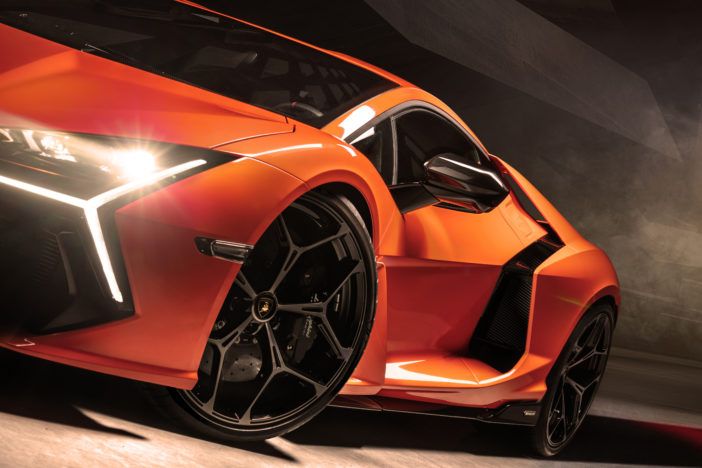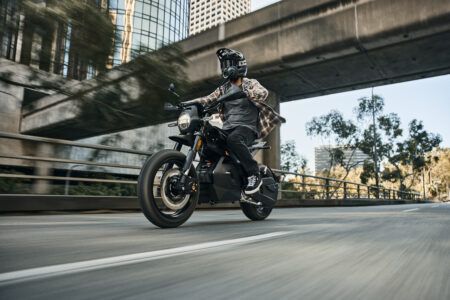Over 380 Lamborghinis are noisily setting a record for a parade lap of Silverstone’s Grand Prix circuit outside as the Italian supercar manufacturer celebrates its 60th anniversary. Sixty years of combustion, though these days even Lamborghini understands the need to embrace electrification for its future products.
Even so, inside, speaking to Rouven Mohr, Chief Technical Officer, Lamborghini, about the new Revuelto there’s still a lot of love for the ICE. “What was clear from the beginning is that the car needs to have the V12, because this defines us and is still our brand positioning,” he says. He does concede that although the car also needs to be a hybrid, that requirement is for the company’s ambition for greater performance as much as it is for environmental reasons. “Of course, we are committed to reducing CO2,” says Mohr, “But the main intention of our drivetrain, of every electric component, is to improve the performance as well as the driving experience.”
The Revuelto is a hybrid, then, with performance up by around 30%, and emissions dropped by a similar amount, but it’s a Lamborghini one. The company describes its new flagship supercar as a High-Performance Electrified Vehicle (HPEV) and that’s irrefutable. Lamborghini’s new range-topping Aventador replacement features not just a 6.5-litre V12 combustion engine, but also three electric motors and a plug-in battery. The combined output of all that is in excess of 1000hp, 825hp of that from the V12, with the remainder from the hybrid system.
The Revuelto is not the company’s first electrically assisted V12, Lamborghini nodded to a hybrid future with its V12 Siân hypercar, an innovative supercapacitor hybrid featuring a 25kW electric motor. Novel, but that solution was ruled out because of its limitations for series production. Mohr explains: “The super capacitor was simply not enough, it’s a cool solution but we only used it as a kind of torque filling and not really for boosting.” With the Revuelto the hybrid system would have to deliver more consistent, and sustained power across a wider range of driving scenarios, as well as allowing electric-only drive, for zero emissions running.

From the outset Mohr was insistent that the hybrid should be homogenously integrated, in relation to the driving behaviour. “Our mission is always that the customer, the driver, should not recognise anything about the magic behind the scenes,” he says. “Everything has to support the driver. And it must be very consistent and to do it this in a natural way, because I can tell you there are a lot of sophisticated concepts on the market where it feels artificial, the car does not feel natural.”
To ensure that the Revuelto delivers the driving experience Mohr wants and Lamborghini’s customers expect has meant a great deal of time in testing. “If you compare the application time of this kind of car compared to standard car it’s more than four times to avoid any negative implications,” he says. “On this we are very, very strict. We spent more than three months only on the ice lake. Not because we think that the customer will use the car on the ice lake, but in these conditions, you feel the different surface changes. There you really perceive every defect on the application quality. If you drive some of the competitors there you feel that the job has been ended a little bit, from my point of view, too early.”
With a background in dynamics, Mohr’s clearly passionate about how the car drives, and the performance, and the feelings it delivers. There’s added weight because of the hybrid system, by around 180kg, but Mohr says you don’t feel it. “From the drivability it feels much lighter, much more compact.” The hybrid system is, admits Mohr, instrumental in bringing greater opportunities in relation to the overall driving experience. Though it’s required some creativity to package it all within the Revuelto’s carbonfibre monocoque structure.
The battery – a compact pouch cell 3.8 kWh lithium-ion which can be recharged via a 7kW domestic power outlet in 30 minutes or via brake regeneration and engine power – is situated in what once would have been referred to as the transmission tunnel. That battery powers a pair of electric motors on the front axle, these being axial flux motors, supplied by YASA in the UK. “They’re really something very special,” says Mohr. “Particularly in relation to torque output, which at 350Nm each is more than double that of a radial flux alternative. They’re not quite as efficient, and you need a bit more space, but for us it was the perfect solution.”
The third motor is integrated into the dual clutch transmission 8-speed gearbox. It’s built by Dana (Graziano), but Mohr says the design layout was dictated internally by Lamborghini. The compact transverse transmission weighs just 193kg and contains a 110kW/150Nm electric motor which doubles as a starter motor and generator, as well as supplementing the V12’s output and being able to deliver power to the rear wheels when driving in electric only mode – in which the Revuelto remains four-wheel drive. In electric only configuration it can cover around 8 miles.
“The gearbox is a piece of art,” says Mohr, “There are so many detailed technical solutions with this gear box. We have a very smart integration of the electric motor as it’s not between the engine and the gearbox like usual. We can also use the gear box and the electric motor as a kind of traction control. It sounds strange, but instead of cutting the engine torque, we are braking the engine when we need traction control with the e-motor, recuperating energy when doing so. This is very smart and it’s also it’s very smooth and controllable.”

A very Lamborghini approach to hybrid integration, and one in which the emphasis is very much on performance. “From my perspective it’s the first car – at least in the sports segment – where no one will say, ‘I see disadvantages because of the hybrid components,’” says Mohr, “Because [with the Revuelto] it’s only positive. It’s like first violin in orchestra – the first violin here must be the V12, and all the rest is arranged around it to make the performance better or to make the emotions higher. Unfortunately, right now you’ll have to trust me on this, but you will drive it later this year and then you can charge me if I’m wrong!”
In a further sixty-years’ time it’ll almost certainly be considered a dinosaur alongside Lamborghini’s as-yet unseen future products which will inevitably embrace greater electrification. But here and now, Lamborghini’s integration of a plug-in hybrid system is impressively singular in its intent, remaining true to its outrageous past, yet respectfully bowing to the necessity of an electrifying world in a manner that perhaps only Lamborghini can.





